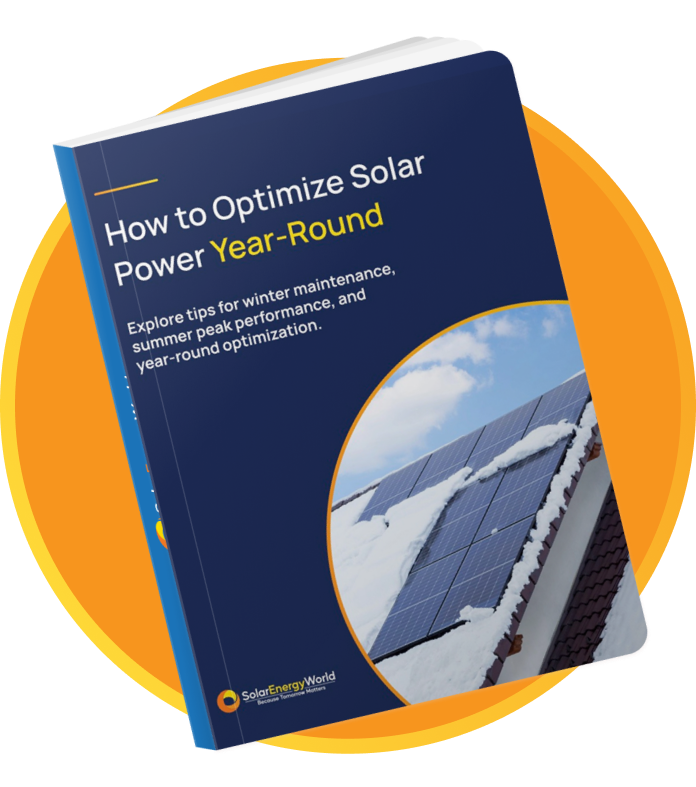Article
How to Optimize and Monitor Your Solar Panel Performance

Installing a renewable energy system is a surefire way to reduce monthly utility bills and increase your personal sustainability. Once your system is installed, how can you boost the efficiency of your solar panels and ensure the ultimate return on your investment? In order to optimize solar panel efficiency, it’s essential to monitor solar panel performance and put the data you gather to good use.
Join us as we discuss the tools you need to monitor solar panel performance and optimize solar panel efficiency!
Optimize Solar Panel Efficiency
Making the most of your solar panel array requires careful observation and a little fine-tuning. Let’s discuss what it means to optimize solar panel efficiency and why it matters.
Importance of Optimization
Optimizing solar panel efficiency allows you to maximize the energy output of your photovoltaic system to ensure you’re getting the best return on your investment. In other words, it helps you make the most of your renewable energy system to reap all the advantages of your array. You’ll further reduce your reliance on the grid, lower your monthly energy costs, and extend the lifespan of your array.
Factors Affecting Efficiency
No two solar installations are the same, but certain factors universally affect the generation capacity of solar panels, including:
Location
Your geographic location plays a big role in solar panel efficiency. For instance, panels installed closer to the equator tend to receive more peak sunlight hours each day than those farther north. Your region’s average temperature levels, weather patterns, and climate will also determine your array’s overall output. Particularly hot environments, areas that experience significant cloud cover, and those with extreme weather events may not be ideal for optimized solar panel efficiency.
Shading
When installing a solar array on your rooftop or property, consider how nearby trees, buildings, or chimneys may interfere with available sunlight. Shadows will migrate throughout the year, so choose a spot that’s free from shading in all four seasons. In some cases, microinverters and power optimizers may minimize the effects of shading.
Tilt and Orientation
Proper positioning also improves energy collection. As your proximity to the equator shifts, so does the appropriate orientation of your solar panel array. An experienced solar installation expert can help you determine the perfect tilt and orientation for your solar panel array.

Learn How to Optimize Solar Power Year-Round
Best Practices for Maintenance
Keeping your solar panel array in good condition requires minimal maintenance, but you’ll want to monitor performance and care for your system to optimize solar panel efficiency.
Regular Cleaning
Dust, pollen, and debris can block sunlight and inhibit your solar array’s generation capacity. Every few months, use a soft brush or squeegee to gently eliminate any buildup on the surface.
Inspect for Damage
Routine inspections throughout the year can save you major repair costs in the future and ensure optimal solar panel performance. Assess your panels for cracks, scratches, and discoloration. Look for gaps and cracks where the mounting hardware meets your roof. Inspect all wiring for damage and loose lines that could impact energy output. Resolve any issues immediately to prevent system failures and other disruptions.
Monitor Solar Panel Performance
Monitor your solar panel performance from the time of initial installation and keep an eye on irregularities and unexpected disruptions that could indicate an underlying problem. We’ll take a closer look at the best ways to do this in order to optimize efficiency below.
How to Monitor Solar Panel Performance Tracking
Modern photovoltaic systems include an inverter that converts the direct-current energy collected from sunlight into usable alternating-current electricity. This device also records valuable data to help you monitor solar panel performance, and tracking this information can give you insight into long-term production trends.
If you choose a professional solar installation, you should have access to ongoing live monitoring services that display your PV array’s stats in real time and compile historical data in easily accessible graphs and charts. Various inverter brands like Tesla, SolarEdge, and Enphase include proprietary apps, software, and web portals that make it easy to log on and monitor solar panel performance.
Standalone smart meters, energy consumption monitors, and weather sensors can break down factors that are harder to quantify, such as environmental fluctuations, to help you understand the data in granular detail and further optimize solar panel efficiency. When used together, these systems can identify performance trends, troubleshoot potential issues, and ensure the highest possible return on investment.
How to Check if My Solar Panels Are Performing Well
When you’re sick, your body sends various signals alerting you to a potential problem. Perhaps your energy levels drop, you feel a tickle in your throat, and it takes a little longer than usual to work through mental tasks. Unless you take steps to heal, there’s a good chance you’ll crash.
Your solar panel array works similarly. Mechanical and environmental issues manifest in many ways – you just need to know the symptoms.
As you monitor solar panel performance, keep an eye out for diminished energy production levels that don’t correlate with environmental factors. This is where long-term solar panel performance tracking can save the day. Compare your current rates to historical data over weeks, months, or years. Lower-than-expected energy generation can signal debris accumulation, unanticipated shading, or equipment malfunctions. Frequent system failures are another sign that something isn’t working correctly.
While many cutting-edge apps and dashboards simplify this information, there are several ways to manually measure solar output. A digital multimeter measures the DC voltage at each panel terminal. Just be sure to turn off the inverter and disconnect the panel before testing. Alternatively, a clamp meter can offer live monitoring using the amps flowing from panels to the inverter. Simply clamp the meter to a DC wire connected to a panel, then compare the reading to the anticipated amperage listed on the product’s spec sheet.
How to Increase the Efficiency of My Solar Panels
Ready to optimize your solar panel array for peak efficiency? Let’s discuss how to make the most of your renewable energy system.
Simple Maintenance Tips
Here’s a simplified checklist to help you keep your array in prime condition to optimize solar panel performance:
Weekly:
- Monitor solar panel performance vs. energy usage.
- Visually inspect your array for obstructions.
Monthly:
- Inspect the inverter display to ensure it’s functioning properly.
- Look over panels for dust, pollen, leaves, and bird droppings.
- Inspect panels and mounting hardware for pest activity and signs of damage.
Quarterly:
- Trim tree branches or vegetation that may create shade.
- Inspect weatherproofing on wires and various connections.
Annually:
- Assess energy storage.
- Schedule professional maintenance, if needed.
- Review warranty coverage and insurance policy.
Upgrading Your System
It’s important to remember that even cutting-edge solar technology will eventually begin to wear down. High-quality Tier One solar panels can easily last over 25 years with proper maintenance, losing about 0.30% efficiency each year. Cheaper models tend to degrade more quickly, sometimes by as much as 1% annually.
You have a couple of options when your solar array begins to show its age. You can install additional battery storage to maximize the amount of solar energy available, or you could replace your panels with high-efficiency upgrades. Many top-of-the-line solar panels feature efficiency ratings of 22% to 24% compared to 15% to 18% found in older models. They capture more sunlight per square foot and perform better in low-light conditions.
Optimizing and Monitoring Solar Panel Efficiency
The experts at Solar Energy World are here to help you monitor solar panel performance and optimize efficiency for the highest return on your investment. Begin your journey to a more sustainable future with a free solar estimate!
Want a Free Solar Estimate?
Fill out the form to get started today.


